The Solvent Recovery Systems Market is estimated to be valued at USD 1.6 billion in 2025 and is projected to reach USD 3.0 billion by 2035, registering a compound annual growth rate (CAGR) of 6.5% over the forecast period.
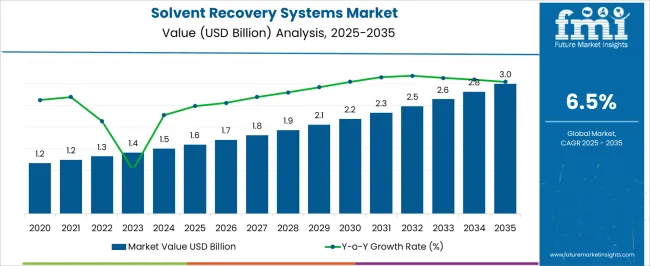
| Metric | Value |
|---|---|
| Solvent Recovery Systems Market Estimated Value in (2025 E) | USD 1.6 billion |
| Solvent Recovery Systems Market Forecast Value in (2035 F) | USD 3.0 billion |
| Forecast CAGR (2025 to 2035) | 6.5% |
The Solvent Recovery Systems market is experiencing steady growth as industries increasingly focus on sustainability, cost efficiency, and regulatory compliance. The current scenario is defined by the adoption of systems capable of recovering solvents from industrial processes, thereby reducing environmental impact and minimizing chemical waste.
Growing emphasis on process optimization and resource management is driving the integration of advanced recovery technologies across sectors including pharmaceuticals, chemicals, and food processing. Investments in automation and process control have enhanced the efficiency and reliability of solvent recovery operations, enabling higher recovery rates and reduced operational downtime.
Future growth is expected to be shaped by rising environmental regulations, corporate sustainability initiatives, and increasing energy efficiency demands As industries seek to optimize solvent usage while reducing emissions and chemical disposal costs, solvent recovery systems are positioned as a critical component in achieving both economic and environmental objectives.
The solvent recovery systems market is segmented by type of solvent recovered, solvent recovery technology, component, end use, and geographic regions. By type of solvent recovered, solvent recovery systems market is divided into Non-Azeotropic Solutions, Aqueous Non-Azeotropic Solutions, Heterogeneous Azeotropic Solutions, and Aqueous Homogeneous Azeotropic Solutions. In terms of solvent recovery technology, solvent recovery systems market is classified into Fractionation, Azeotropic Distillation, and Extractive Distillation. Based on component, solvent recovery systems market is segmented into System and Accessories. By end use, solvent recovery systems market is segmented into Pharmaceutical, Electronics, Agrochemicals, Chemical, Cosmetics, and Others. Regionally, the solvent recovery systems industry is classified into North America, Latin America, Western Europe, Eastern Europe, Balkan & Baltic Countries, Russia & Belarus, Central Asia, East Asia, South Asia & Pacific, and the Middle East & Africa.
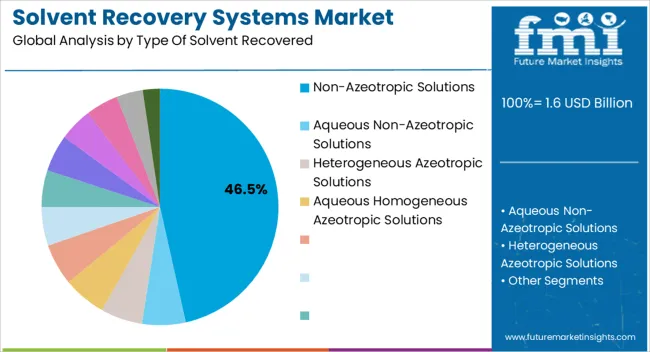
The Non-azeotropic Solutions type is projected to hold 46.50% of the Solvent Recovery Systems market revenue in 2025, making it the leading segment in terms of solvent recovered. This dominance is attributed to the efficiency of these systems in separating mixed solvents with differing boiling points, allowing industries to recover multiple solvents simultaneously without significant loss. Adoption has been accelerated by the growing need for cost-effective solvent management and the increasing focus on environmental compliance.
Non-azeotropic solutions allow high-purity recovery and improved process control, reducing the need for additional chemical inputs. Furthermore, industries benefit from reduced operational costs and enhanced safety due to lower solvent handling and storage requirements.
The segment’s growth is reinforced by ongoing advancements in separation technologies and rising demand from large-scale manufacturing facilities that prioritize energy-efficient and sustainable operations The ability to recover solvents with minimal process disruption makes non-azeotropic solutions a preferred choice in contemporary industrial applications.
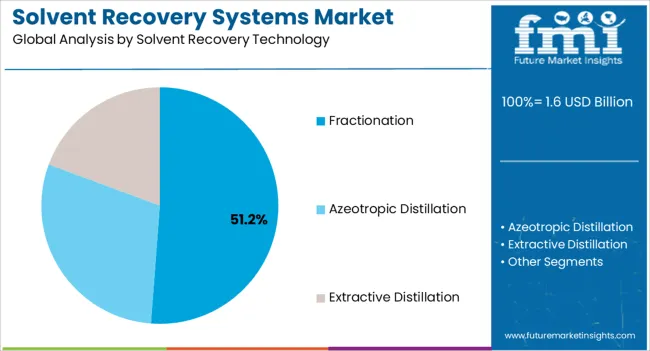
The Fractionation technology segment is expected to capture 51.20% of the total Solvent Recovery Systems market revenue in 2025, emerging as the leading solvent recovery technology. This prominence is being driven by the ability of fractionation systems to achieve high purity levels through efficient separation based on boiling points. Industries adopt fractionation technologies for their flexibility in handling diverse solvent types and their compatibility with continuous and batch processes.
The growth of this segment has been facilitated by increased automation and monitoring capabilities, which ensure precise control over separation parameters and minimize solvent losses. Fractionation systems offer both operational efficiency and regulatory compliance benefits, particularly in sectors where solvent purity is critical.
As organizations focus on sustainable chemical management and cost optimization, the demand for fractionation technology continues to rise The combination of process reliability, high recovery rates, and adaptability to different industrial applications positions fractionation as the preferred technology choice in solvent recovery systems.
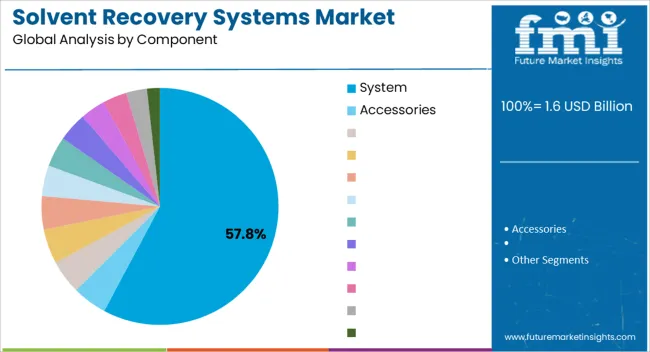
The System component segment is projected to hold 57.80% of the Solvent Recovery Systems market revenue in 2025, making it the dominant component category. This leadership is attributed to the comprehensive nature of system-level solutions, which integrate recovery units, condensers, and process controls into a cohesive operation capable of handling large-scale industrial demands. Adoption has been driven by the need for turnkey solutions that reduce setup complexity, optimize recovery efficiency, and ensure operational reliability.
System components allow seamless integration with existing process lines, reducing downtime and minimizing maintenance requirements. Additionally, the modular design of many system components enables scalable deployment across diverse industries, supporting both batch and continuous recovery operations.
Increased emphasis on energy efficiency, process automation, and environmental compliance has further strengthened the position of system components in the market The ability to deliver consistent recovery rates, reduce solvent losses, and streamline operations ensures continued preference for system-level solutions in modern industrial applications.
Recycling and reusing the solvent is an essential requirement of any industry because it saves money required for purchasing new solvents. Thus, solvent recovery systems are essential and important from productivity prospective for any industry.
A solvent recovery system includes the process of extracting valuable and useful materials from waste or by-product solvents which are generated during the manufacturing process. The chemicals which are being recovered and recycled by the solvent recovery systems are repurposed by the industries by eliminating waste and removing hazardous substances from the leftover substances. With the development of industries, the associated solvent recovery systems also need to be renovated.
Thus, the solvent recovery system is expected to have better growth opportunities during the forecast period.
A solvent recovery system reduces raw material and solvent costs as well as transportation and disposal costs of the chemicals. Also, a solvent recovery system lowers the EPA reporting requirement and risk owing to the less disposal of industrial solvents.
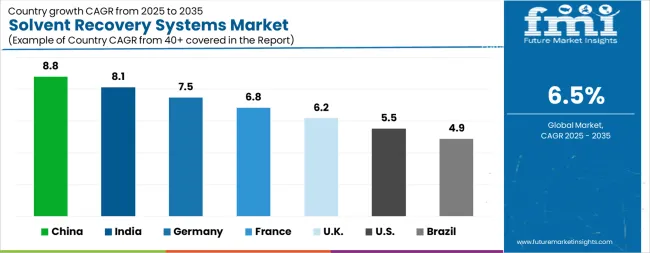
| Country | CAGR |
|---|---|
| China | 8.8% |
| India | 8.1% |
| Germany | 7.5% |
| France | 6.8% |
| UK | 6.2% |
| USA | 5.5% |
| Brazil | 4.9% |
The Solvent Recovery Systems Market is expected to register a CAGR of 6.5% during the forecast period, exhibiting varied country level momentum. China leads with the highest CAGR of 8.8%, followed by India at 8.1%. Developed markets such as Germany, France, and the UK continue to expand steadily, while the USA is likely to grow at consistent rates. Brazil posts the lowest CAGR at 4.9%, yet still underscores a broadly positive trajectory for the global Solvent Recovery Systems Market. In 2024, Germany held a dominant revenue in the Western Europe market and is expected to grow with a CAGR of 7.5%. The USA Solvent Recovery Systems Market is estimated to be valued at USD 579.3 million in 2025 and is anticipated to reach a valuation of USD 991.8 million by 2035. Sales are projected to rise at a CAGR of 5.5% over the forecast period between 2025 and 2035. While Japan and South Korea markets are estimated to be valued at USD 75.2 million and USD 44.7 million respectively in 2025.
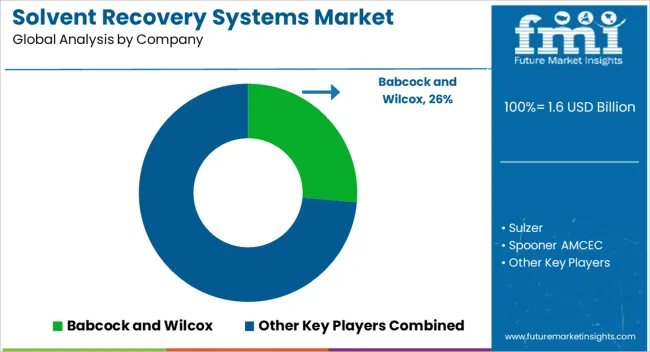
| Item | Value |
|---|---|
| Quantitative Units | USD 1.6 Billion |
| Type Of Solvent Recovered | Non-Azeotropic Solutions, Aqueous Non-Azeotropic Solutions, Heterogeneous Azeotropic Solutions, and Aqueous Homogeneous Azeotropic Solutions |
| Solvent Recovery Technology | Fractionation, Azeotropic Distillation, and Extractive Distillation |
| Component | System and Accessories |
| End Use | Pharmaceutical, Electronics, Agrochemicals, Chemical, Cosmetics, and Others |
| Regions Covered | North America, Europe, Asia-Pacific, Latin America, Middle East & Africa |
| Country Covered | United States, Canada, Germany, France, United Kingdom, China, Japan, India, Brazil, South Africa |
| Key Companies Profiled | Babcock and Wilcox, Sulzer, Spooner AMCEC, Wintek, HongYi, and Kroeschell |
The global solvent recovery systems market is estimated to be valued at USD 1.6 billion in 2025.
The market size for the solvent recovery systems market is projected to reach USD 3.0 billion by 2035.
The solvent recovery systems market is expected to grow at a 6.5% CAGR between 2025 and 2035.
The key product types in solvent recovery systems market are non-azeotropic solutions, aqueous non-azeotropic solutions, heterogeneous azeotropic solutions and aqueous homogeneous azeotropic solutions.
In terms of solvent recovery technology, fractionation segment to command 51.2% share in the solvent recovery systems market in 2025.






Our Research Products

The "Full Research Suite" delivers actionable market intel, deep dives on markets or technologies, so clients act faster, cut risk, and unlock growth.

The Leaderboard benchmarks and ranks top vendors, classifying them as Established Leaders, Leading Challengers, or Disruptors & Challengers.

Locates where complements amplify value and substitutes erode it, forecasting net impact by horizon

We deliver granular, decision-grade intel: market sizing, 5-year forecasts, pricing, adoption, usage, revenue, and operational KPIs—plus competitor tracking, regulation, and value chains—across 60 countries broadly.

Spot the shifts before they hit your P&L. We track inflection points, adoption curves, pricing moves, and ecosystem plays to show where demand is heading, why it is changing, and what to do next across high-growth markets and disruptive tech

Real-time reads of user behavior. We track shifting priorities, perceptions of today’s and next-gen services, and provider experience, then pace how fast tech moves from trial to adoption, blending buyer, consumer, and channel inputs with social signals (#WhySwitch, #UX).

Partner with our analyst team to build a custom report designed around your business priorities. From analysing market trends to assessing competitors or crafting bespoke datasets, we tailor insights to your needs.
Supplier Intelligence
Discovery & Profiling
Capacity & Footprint
Performance & Risk
Compliance & Governance
Commercial Readiness
Who Supplies Whom
Scorecards & Shortlists
Playbooks & Docs
Category Intelligence
Definition & Scope
Demand & Use Cases
Cost Drivers
Market Structure
Supply Chain Map
Trade & Policy
Operating Norms
Deliverables
Buyer Intelligence
Account Basics
Spend & Scope
Procurement Model
Vendor Requirements
Terms & Policies
Entry Strategy
Pain Points & Triggers
Outputs
Pricing Analysis
Benchmarks
Trends
Should-Cost
Indexation
Landed Cost
Commercial Terms
Deliverables
Brand Analysis
Positioning & Value Prop
Share & Presence
Customer Evidence
Go-to-Market
Digital & Reputation
Compliance & Trust
KPIs & Gaps
Outputs
Full Research Suite comprises of:
Market outlook & trends analysis
Interviews & case studies
Strategic recommendations
Vendor profiles & capabilities analysis
5-year forecasts
8 regions and 60+ country-level data splits
Market segment data splits
12 months of continuous data updates
DELIVERED AS:
PDF EXCEL ONLINE
Solvent Recycling & Recovery Equipment Market Size and Share Forecast Outlook 2025 to 2035
Starch Recovery Systems Market Outlook – Growth, Demand & Forecast 2023-2033
APAC Waste Heat Recovery Systems Market Size and Share Forecast Outlook 2025 to 2035
Automotive Energy Recovery Systems Market Size and Share Forecast Outlook 2025 to 2035
Solvent Degassing System Market Size and Share Forecast Outlook 2025 to 2035
Solvent-Free Natural Color Dispersions Market Analysis - Size, Share, and Forecast Outlook 2025 to 2035
Systems Administration Management Tools Market Size and Share Forecast Outlook 2025 to 2035
VRF Systems Market Growth - Trends & Forecast 2025 to 2035
Heat Recovery System Generator Market Size and Share Forecast Outlook 2025 to 2035
Heat Recovery Steam Generator Market Growth – Trends & Forecast 2025 to 2035
Cloud Systems Management Software Market Size and Share Forecast Outlook 2025 to 2035
Hi-Fi Systems Market Size and Share Forecast Outlook 2025 to 2035
Green Solvents Market Growth – Trends & Forecast 2024-2034
Cough systems Market
Vapour Recovery Units Market Size and Share Forecast Outlook 2025 to 2035
Citrus Solvents Market Insights Trends & Forecast 2025 to 2035
Market Share Insights of Vapour Recovery Unit Providers
Energy Recovery Ventilator Core Market Growth – Trends & Forecast 2024-2034
Global Fitness Recovery Services Market Analysis Size and Share Forecast Outlook 2025 to 2035
Sulphur Recovery Technology Market Analysis - Size, Share, and Forecast Outlook 2025 to 2035

Thank you!
You will receive an email from our Business Development Manager. Please be sure to check your SPAM/JUNK folder too.
Chat With
MaRIA